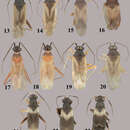Description
(
anglais
)
fourni par Zookeys
Male (n = 4; plus holotype in parentheses) (Fig. 19): Length to apex of hemelytron 2.75–2.58 mm (2.55 mm), length to base of cuneus 2.90–2.05 mm, width across hemelytra 0.88-0.93 mm (0.86 mm). Head: Length 0.32–0.34 mm (0.30 mm), width across eyes 0.59–0.61 mm (0.59 mm), interocular width 00.27–0.29 mm (0.27 mm). Labium: Length 1.12–1.14 mm (1.12 mm). Antenna: Segment I length 0.30–0.34 mm (0.32 mm), II 0.91–1.07 (1.02 mm), III 0.54–0.64 mm (0.58 mm), IV 0.51–0.64 mm (missing). Pronotum: Length 0.34–0.35 mm (0.32 mm), basal width 0.78–0.82 mm (0.77 mm).
Coloration: Head: Uniformly fuscous to black, with a large, distinct, pale yellow, interocular spot near inner margin of each eye, spots nearly contiguous in some specimens; eyes reddish brown, often fading to silver with a reddish tinge. Labium: Uniformly pale yellow; apex of segment IV dark brown to fuscous. Antenna: Segment I fuscous to black, with apical one fourth yellow (length of yellow area equal to diameter of segment) and narrowed basal one fourth shiny; segment II dark brown to black (basal area darker on “paler” dark brown segments); segments III and IV dark brown to fuscous. Pronotum: Uniformly shiny fuscous, weakly swollen calli sometimes very slightly paler brown. Mesoscutum: Dark brown to fuscous, lateral angles pale yellow on some specimens. Scutellum: Dark brown to fuscous, slightly paler apically. Hemelytron: Pale translucent smoky brown to dirty white; veins brown and often narrow inner margin of clavus brown. Ostiolar evaporative area: Dark brown to fuscous, often invaded with pale areas posteriorly. Ventral surface: Thorax uniformly dark brown to fuscous; abdomen dark brown to fuscous laterally, pale ventrally, genital capsule black. Legs: Coxae pale brownish yellow, with bases brown; femora uniformly pale yellow to whitish; tibia pale yellow to whitish with spines and bases, or knees, dark brown to fuscous; tarsi and claws pale yellow.
Structure, texture, and vestiture: Head: Shiny, impunctate, wider than long; buccula relatively narrow, ending posteriorly near level with middle of eye; sparsely set with long, erect and suberect, pale brown to brown setae. Labium: Extending to bases of hind coxae or just onto abdominal segment II; segment I extending to bases of fore coxae. Antenna: Segment I with short, recument setae and two long, black, bristlelike setae near apex before pale area; segment II thickly set with short, recumbent pale brown setae much shorter than diameter of segment. Pronotum: Shiny, impunctate; calli weakly swollen but distinct; anterior rounded; lateral margins concave, strongly flaring at posterior angles; posterior margin weakly sinuate; set with short, erect to semierect setae. Mesoscutum: Shiny, impunctate, broadly exposed; with numerous semierect and recumbent, pale brown setae. Scutellum: Shiny, impunctate; thickly set with semierect and recumbent pale brown setae. Hemelytron: Macropterous, subparallel when paired, with fully developed cuneus and membrane, extending well beyond apex of abdomen; evenly scattered with short, recumbent, pale brown setae.
Male genitalia: (Fig. 144): Mitt-shaped; right arm longest, stout, slightly constricted basally, weakly pointed apically; left arm short, apically acute. Right paramere (Fig. 145): Elongate oval, strongly rounded apically. Endosoma (Fig. 146): C-shaped, nearly S-shaped with apical quarter curving slightly upward. Phallotheca (Fig. 147): moderately stout, apically acute.
Female:(n = 2) (Fig. 20): Length to apex of hemelytron 2.88–2.93 mm, length to base of cuneus 2.10–2.23 mm, width across hemelytra 0.99–1.04 mm. Head: Length 0.32–0.37 mm, width across eyes 0.61–0.62 mm, interocular width 0.29–0.30 mm. Labium: Length 1.20–1.22 mm. Antenna: Segment I length 0.29–0.30 mm, II 0.88–0.91 mm, III 0.61–0.64 mm, IV 0.61–0.62 mm. Pronotum: Length 0.35–0.37 mm, basal width 0.86–0.88 mm.
Similar to male in general color and pubescence, differing primarily in the slightly broader form.
- licence
- cc-by-3.0
- droit d’auteur
- Thomas J. Henry
- citation bibliographique
- Henry T (2012) Revision of the Plant Bug Genus Tytthus (Hemiptera, Heteroptera, Miridae, Phylinae) ZooKeys 220: 1–114
- auteur
- Thomas J. Henry

